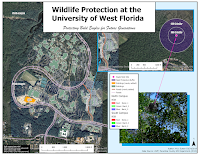Lab 12 [GIS5050L]: Georeferencing, Editing, & 3D

Created using ArcGIS Pro 2.2.0 This week's lab covered three key skills in ArcGIS: georeferencing, editing, and overlaying data in a 3D environment. First, we learned the process to select control points for image registration, referred to as georeferencing. For the map shown on the left, this involved selecting points in the raster image and linking them to their corresponding point in a loaded vector feature class (e.g., corner of a building). Several transformations were possible based on the number of control points selected, target root mean square error (RMSE) values, and the desired appearance of the final registration (e.g., choosing a 1st or 2nd order polynomial transformation based on which one minimized RMSE or distortion). This week's lab also emphasized editing of feature classes in the form of adding polygons and lines to existing building and road feature classes, respectively. The process of digitizing these features was based on using the outline of t...



